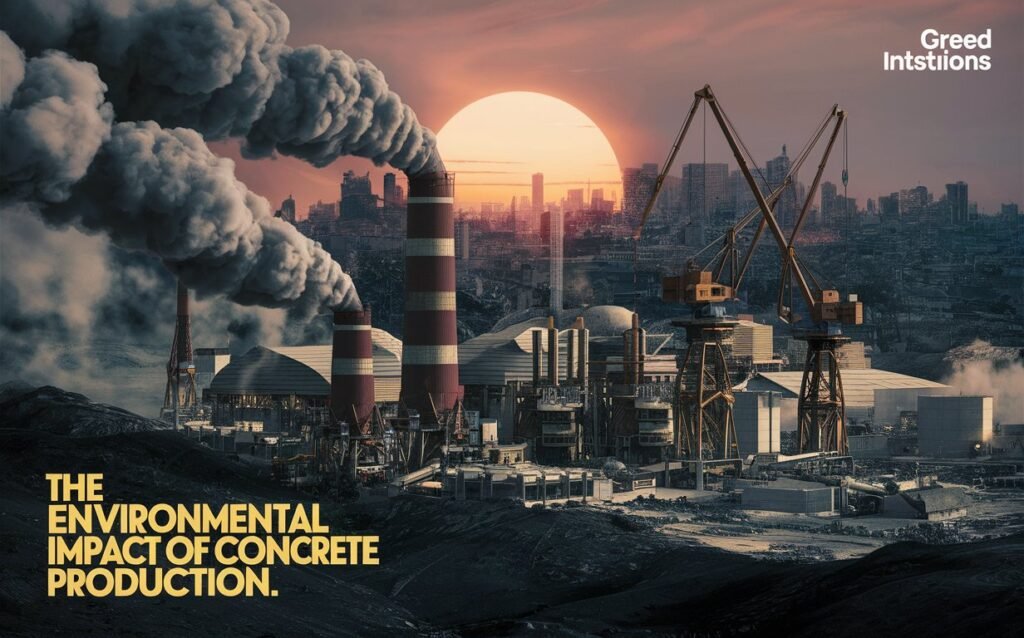Concrete is indispensable in today’s world, supporting everything from towering skyscrapers to highways, homes, and bridges. However, the environmental toll behind this essential building material is often overlooked. Concrete’s popularity is growing alongside the surge in global construction projects, and with it, so is its environmental footprint.
The process of producing concrete is riddled with hidden environmental costs, from vast amounts of carbon emissions to severe strain on water resources and even habitat destruction from aggregate mining. Understanding these impacts is crucial, as the concrete industry’s heavy reliance on energy, water, and raw materials makes it one of the most significant contributors to global environmental challenges.
Environmental Problems Caused by Concrete Production
-
Carbon Emissions and Greenhouse Gases
Concrete production is a leading contributor to global carbon emissions, with cement—a key component—responsible for nearly 8% of the world’s CO₂ emissions. Cement production relies on the calcination of limestone, an energy-intensive process that releases carbon dioxide. During calcination, limestone (calcium carbonate) is heated to break it down, releasing CO₂ as a byproduct. The process requires extremely high temperatures, which further contributes to emissions due to the fossil fuels needed to achieve these conditions.
Beyond calcination, additional emissions result from the energy needed to power equipment and transport materials throughout the production process. Combined, these activities make concrete production one of the highest-emitting industrial processes globally.
-
High Energy Consumption
Producing concrete consumes a massive amount of energy, largely because of the energy demands for creating cement. Cement kilns operate at temperatures exceeding 1400°C (2552°F), typically fueled by coal or natural gas. Not only does this process release carbon emissions, but it also depletes finite energy resources, further exacerbating the industry’s environmental impact.
Apart from heating, other production stages add to the cumulative energy demand, such as:
- Grinding
- Mixing
This energy-intensive process underscores concrete’s reliance on fossil fuels, which increases the sector’s overall environmental footprint.
-
Water Usage and Pollution
The concrete industry is one of the largest consumers of water. Large quantities are required in cement production, as well as in mixing and curing concrete during construction. In regions already experiencing water scarcity, this high demand for water strains local resources, which ultimately raises ethical and environmental concerns.
Moreover, wastewater from concrete production can pollute nearby water bodies if not managed properly. Contaminants such as high levels of suspended solids, alkalinity, and trace metals can:
- Harm aquatic ecosystems
- Reduce water quality for surrounding communities
The cumulative impact on water resources is an increasingly urgent concern as global water scarcity continues to rise.
-
Habitat Destruction from Aggregate Mining
Concrete production relies heavily on aggregates such as sand, gravel, and crushed stone, sourced from mining operations. Mining aggregates often leads to:
- Habitat destruction
- Deforestation
- Soil erosion
Riverbeds and coastal areas are particularly impacted by sand extraction, which alters river flow, disrupts aquatic habitats, and damages marine life. The environmental impact of aggregate mining extends beyond the immediate area, potentially affecting entire ecosystems and leading to biodiversity loss.
The demand for aggregates continues to rise, driven by rapid urbanisation and development. This growing need exacerbates the environmental impact on natural habitats, making it a critical issue in concrete production’s overall footprint.
-
Concrete’s Longevity and End-of-Life Waste
One of concrete’s benefits is its durability, as it can last for decades without requiring frequent maintenance. However, when structures reach the end of their lifespan, demolishing concrete produces a considerable amount of construction and demolition (C&D) waste. If not disposed of or managed responsibly, this waste accumulates in landfills, where it takes up significant space and contributes to pollution.
Beyond landfill concerns, the environmental footprint of concrete waste includes the energy and resources required for its demolition, transport, and disposal. The challenge of managing concrete waste becomes even more critical in urban areas, where limited landfill space adds pressure on waste management systems.
Addressing the Environmental Impact of Concrete Production
Efforts to reduce concrete’s environmental footprint focus on addressing emissions, energy consumption, water usage, and waste management. Various approaches are being explored to create more sustainable practices in the industry:
- Lower-carbon alternatives in cement production: By using alternative materials such as fly ash or slag, the industry can reduce reliance on traditional cement. These materials not only cut emissions but also repurpose byproducts from other industries.
- Switching to renewable energy sources: Using renewable energy like wind or solar to power cement production facilities can significantly lower emissions associated with the process.
- Recycling water in production: Closed-loop systems that recycle water within the production process reduce strain on water resources and limit pollution.
- Using recycled aggregates: Crushed concrete from demolished structures can be reused, reducing the need for new aggregate mining and lowering the impact on natural habitats.
- Adopting concrete line pump: Utilising concrete line pumping experts services can help optimise material usage by allowing precise placement of concrete, reducing waste and energy required in construction projects. By minimising over-pouring and unnecessary material usage, this approach contributes to a more efficient and environmentally conscious building process.
- Promoting sustainable demolition and recycling practices: Designing structures with disassembly in mind can facilitate the reuse of materials, while recycling facilities can handle concrete waste more efficiently, reducing landfill accumulation.
Takeaway
Concrete’s contribution to modern life is undeniable; it forms the literal foundation of our cities, infrastructure, and progress. Yet, its environmental costs are equally substantial, spanning high carbon emissions, intensive water use, and extensive waste. As we stand at a crossroads, the construction industry faces the challenge of balancing the need for concrete with the imperative of sustainability. From more efficient production practices to using concrete line pump hire for accurate placement, every effort counts in reducing the industry’s environmental footprint.
Ultimately, the goal is not just to build but to build responsibly—ensuring that future generations inherit a world where progress and sustainability coexist. The time to act is now; the solutions are within our reach.











































